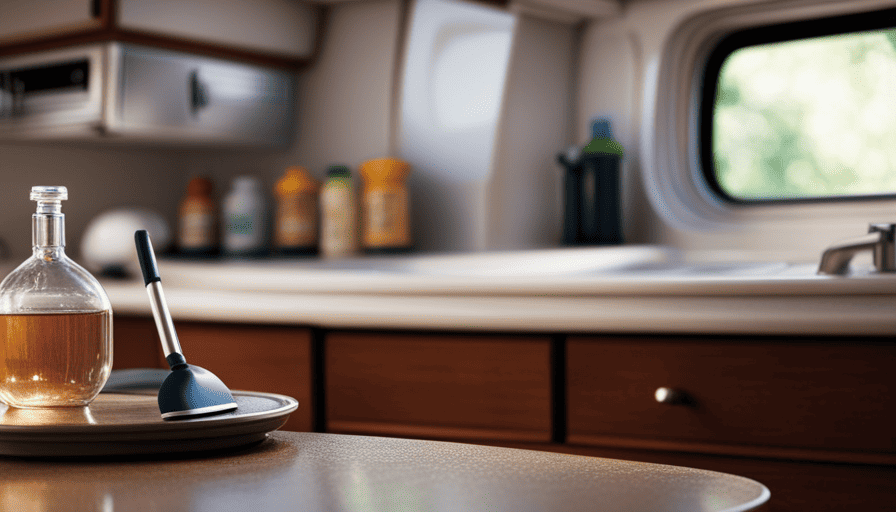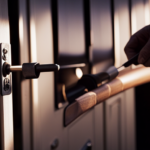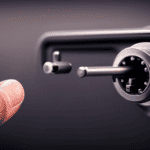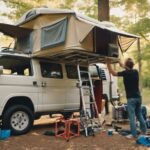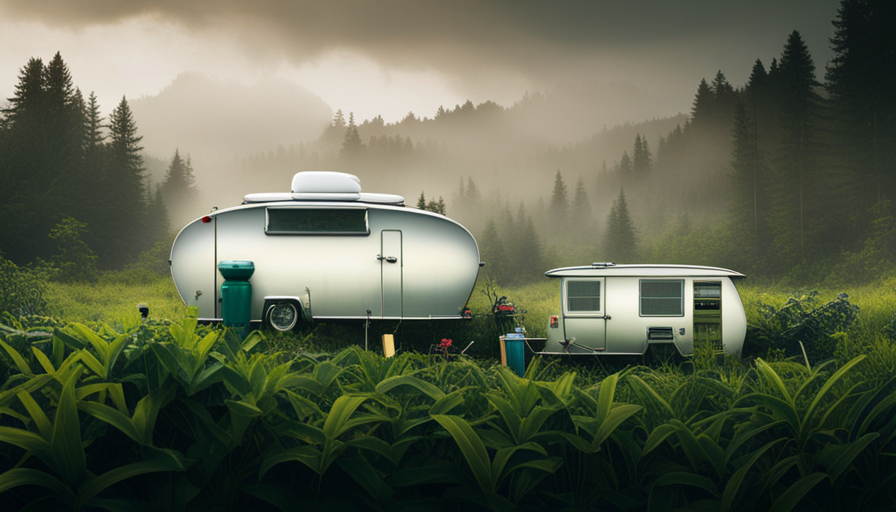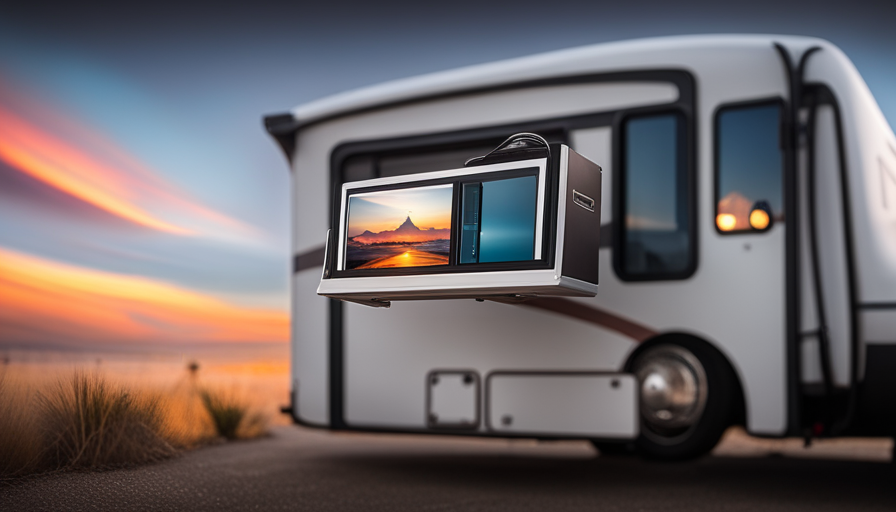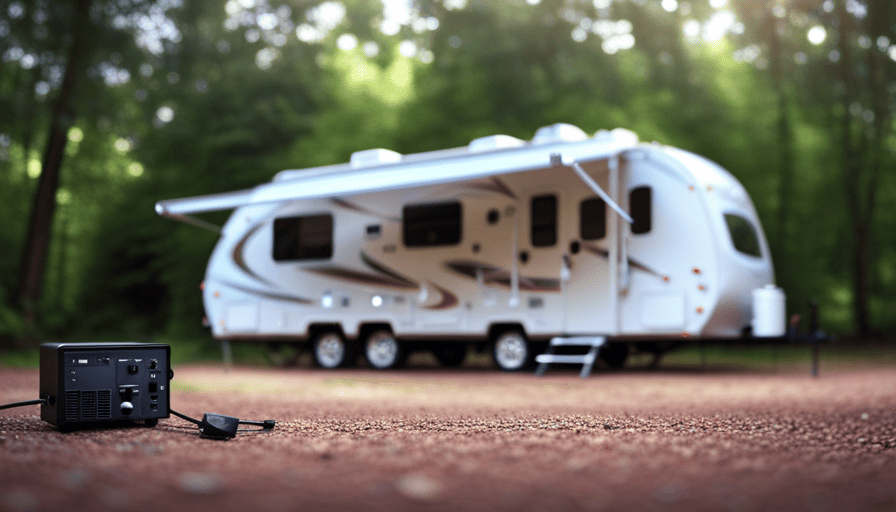Did you know that every year, thousands of campers find themselves locked out of their own vehicles? This frustrating situation can quickly turn a peaceful camping trip into a stressful and worrisome ordeal.
But fear not! In this article, I will provide you with practical and detailed steps on how to get into your camper if you ever find yourself locked out. From using simple tools like a slim jim or a credit card to more advanced methods like removing the door lock, I will guide you through each option, ensuring that you can regain access to your camper safely and efficiently.
Additionally, I will share tips on preventive measures such as installing a keyless entry system, so you never have to face this situation again.
So, if you ever find yourself locked out of your camper, stay calm and follow these steps to get back inside and continue enjoying your camping adventure.
Key Takeaways
- Stay calm and assess the situation before attempting any methods to unlock the camper
- Utilize tools like a slim jim, credit card, or coat hanger to try and unlock the door
- Consider calling a professional locksmith for a safe and efficient resolution
- Take preventive measures such as installing a keyless entry system or creating duplicate keys to avoid future lockouts
Assess the Situation and Stay Calm
Take a deep breath and remember that staying calm is the key to assessing the situation and figuring out how to get back into your camper. When you find yourself locked out, it can be easy to panic, but maintaining a level head will help you think clearly and find a solution.
First, take a moment to assess the situation. Are you alone or with others? Is there anyone nearby who can help? Take stock of your surroundings and look for any potential entry points that may have been overlooked.
Stay calm as you check for open windows or doors. Sometimes, in the rush of leaving the camper, we may have forgotten to lock a window or door properly. Look for any signs of an unlocked entry point, such as a slightly ajar window or a door that may not be fully closed. If you find one, carefully attempt to open it and gain access to your camper. However, if all the windows and doors are securely locked, don’t worry. There are still other methods you can try to regain entry.
Check for Open Windows or Doors
Look around for any open windows or doors, you might just find a way back inside. Checking for alternative entry points is crucial when you’re locked out of your camper.
Start by walking around the camper and carefully inspecting all the windows and doors. Look for any signs of a window or door being left slightly ajar. Sometimes, in the rush to leave or enter the camper, people forget to fully close these entry points. If you’re lucky, you may find a window or door that you can easily open and crawl through to regain access to your camper.
In situations where all the windows and doors are securely closed, seeking assistance from nearby authorities can be your best option. They have the tools and expertise to help you get back into your camper safely. You can try contacting the local police or fire department and explain your predicament. They might be able to provide you with guidance or send someone to assist you.
Now, let’s move on to the next section about using a slim jim or coat hanger to unlock the door. It’s another method you can try if you’re still unable to find an open window or door.
Use a Slim Jim or Coat Hanger to Unlock the Door
Feeling like a resourceful detective, I discovered that using a slim jim or coat hanger is an effective method to unlock the door of my camper. By utilizing household items as lock picking tools, I was able to avoid being locked out in the first place.
To begin, I grabbed a slim jim or a straightened coat hanger and bent one end into a hook shape. I then inserted the hooked end into the small gap between the door and the frame, near the lock mechanism. With a bit of patience and finesse, I maneuvered the slim jim or coat hanger until it reached the lock. By gently pulling upward or pushing downward, I was able to manipulate the lock and unlock the door.
It’s important to note that using a slim jim or coat hanger should be done responsibly and only in emergency situations. Additionally, it may be helpful to familiarize yourself with the locking mechanisms of your camper beforehand to increase your chances of success.
By using this method, I was able to regain access to my camper without causing any damage. However, if this technique doesn’t work for you, there are other options to explore. In the next section, we’ll discuss how to try using a credit card or plastic strip to unlock the door.
Try a Credit Card or Plastic Strip
Attempting to unlock the door of my camper in a sophisticated manner, I decided to explore the option of using a credit card or plastic strip. These alternative methods can be quite handy if you’re locked out of your camper without a key. However, before attempting this technique, it’s important to take some safety precautions.
Here are some steps to follow when using a credit card or plastic strip:
-
Choose a flexible card or strip: Look for a card or strip that’s thin and flexible, like a credit card or a plastic gift card.
-
Insert the card between the door and the frame: Slide the card between the door and the frame at the location of the door latch.
-
Apply pressure: Push the card downwards while simultaneously pushing the door handle or knob to try and disengage the latch.
-
Wiggle the card: While maintaining pressure, wiggle the card up and down, trying to catch the latch and release the door.
It’s important to note that not all doors can be easily unlocked using this method. If you can’t unlock the door using a credit card or plastic strip, another option is to use a screwdriver or pliers to remove the door lock. This technique requires a bit more skill and caution, but it can be effective in gaining access to your camper.
Moving on to the next method, let’s explore how to use a screwdriver or pliers to remove the door lock.
Use a Screwdriver or Pliers to Remove the Door Lock
Using a screwdriver or pliers, you can skillfully manipulate the door lock, visualizing the satisfying click as it disengages and grants you access to your camper. When locked out of your camper, this method can be a lifesaver. If you don’t have a credit card or plastic strip handy, a screwdriver or pliers can be a great substitute tool to help you get back inside.
To begin, locate the door lock on your camper. It’s usually located on the handle or just above it. Insert the screwdriver or pliers into the keyhole and apply gentle pressure. Try to turn the lock in the same direction as you would with a key. Be patient and persistent, as it may take a few tries to get it right. Once you feel the lock start to give, continue turning until you hear the click of it disengaging.
It’s important to note that this method may not work on all camper locks, especially those with more advanced security features. In such cases, it’s best to call a professional locksmith to avoid causing any damage to your camper.
With this alternative method in mind, let’s now discuss the next step of calling a professional locksmith to ensure a safe and efficient resolution to your locked-out situation.
Call a Professional Locksmith
To ensure a safe and efficient resolution to your locked-out situation, it’s advisable to contact a professional locksmith. Calling a locksmith is the best option when you find yourself locked out of your camper and don’t have access to a spare key. They have the expertise and specialized tools to handle different types of locks and can quickly and effectively get you back inside your camper.
When you call a locksmith, be sure to provide them with all the necessary information, such as your location and the make and model of your camper. This will help them come prepared with the right tools and equipment. It’s also a good idea to inquire about their availability and estimated arrival time, so you can plan accordingly.
Once the locksmith arrives, they will assess the situation and determine the best method to unlock your camper without causing any damage. They may use specialized lock picking tools or other techniques to gain access to your camper safely. In some cases, they may need to rekey or replace the lock altogether.
After the locksmith has successfully unlocked your camper, it’s a good idea to ask for their advice on how to prevent future lockouts. They may recommend getting a spare key made or investing in a keyless entry system. With their expertise, you can ensure that you have a reliable solution for any future lockout situations.
Now, let’s move on to the next step and explore how to ask for help from other campers or campground staff.
Ask for Help from Other Campers or Campground Staff
If you find yourself locked out of your camper, reach out to other campers or campground staff for assistance. They can offer alternative lockout solutions and help you get back into your camper quickly.
Other campers may have experienced the same situation before and can provide you with helpful tips or tricks to unlock your camper. Campground staff are also knowledgeable about the campers in the area and may have access to master keys or tools that can help you regain entry.
When asking for help, be sure to explain your situation clearly and politely. Give as much information as possible about the type of lock on your camper and any attempts you’ve made to unlock it. This will help others understand the problem and come up with effective solutions.
In addition to seeking help, it’s important to learn from this experience and take steps to prevent future lockouts. Always have a spare key or remote control accessible, either by keeping it on your person or in a secure location outside of the camper. You can also consider installing a keyless entry system or a combination lock for added convenience and security.
Transitioning into the next section, one option for preventing lockouts is to use a spare key or remote control.
Use a Spare Key or Remote Control
Having a spare key or remote control can be a lifesaver when you find yourself in a lockout situation at the campground. Here are three alternatives to consider if you don’t have access to a spare key or remote control:
-
Hide a spare key: Find a discreet spot near your camper where you can securely hide a spare key. It could be under a rock, inside a fake rock, or even attached to the underside of your camper. Just make sure it’s well-hidden and not easily accessible to others.
-
Contact a locksmith: If you’re unable to locate a spare key or remote control, it’s best to call a professional locksmith. They have the expertise and tools to safely open your camper without causing any damage. Keep the contact information of a reliable locksmith handy in case of emergencies.
-
Contact the camper manufacturer: Reach out to the manufacturer of your camper and inquire about any alternative ways to gain access to your camper. They may have specific instructions or advice tailored to your camper model.
When using any spare key alternative, always prioritize safety precautions. Ensure that you’re in a secure location and have proper identification to prove ownership of the camper.
In the future, consider installing a keyless entry system for added convenience and peace of mind. This system eliminates the need for physical keys and allows you to access your camper using a unique code or smartphone app. Transitioning to a keyless entry system can make lockout situations a thing of the past.
Install a Keyless Entry System for Future Convenience
After considering the option of using a spare key or remote control to gain access to your locked camper, let’s explore a more convenient and long-term solution: installing a keyless entry system.
A keyless entry system is a modern way to secure and access your camper without the need for traditional keys. It typically utilizes a keypad or a key fob that allows you to lock and unlock your camper with just a few simple button presses.
There are several advantages to installing a keyless entry system. Firstly, it eliminates the risk of losing or misplacing your keys, which can be a common occurrence during camping trips. With a keyless system, all you need to remember is a passcode or carry a small key fob. Secondly, it provides added security as the system often includes features like an alarm and a panic button. Lastly, it offers convenience by allowing you to remotely lock or unlock your camper from a distance, making it easier to load and unload your belongings.
By installing a keyless entry system, you can enjoy the benefits of convenience, security, and peace of mind. However, even with this advanced technology, it’s essential to learn from the experience and take preventive measures to avoid any future lockout situations.
Learn from the Experience and Take Preventive Measures
To avoid future lockout situations, make sure to learn from your experience and take preventive measures. Being locked out of your camper can be a frustrating and stressful experience, so it’s important to take steps to prevent it from happening again.
By implementing the following preventive measures, you can save yourself from the hassle and inconvenience of a lockout:
-
Install a spare key lockbox: Keeping a spare key hidden in a lockbox outside your camper can be a lifesaver in case you accidentally lock yourself out. Just make sure to choose a secure location and regularly change the access code to maintain security.
-
Create duplicate keys: It’s always a good idea to have duplicate keys for your camper. Keep one set with a trustworthy friend or family member and another set in a safe place at home. This way, you’ll have backup keys available if you misplace or lose your primary set.
-
Develop a routine: Establish a habit of double-checking your keys before leaving your camper. Make it a part of your departure checklist to ensure you have your keys with you before locking the door.
-
Use a keyless entry system: Consider installing a keyless entry system for added convenience and security. These systems use a keypad or remote control to unlock your camper, eliminating the risk of losing or forgetting your keys.
By taking these preventive measures, you can significantly reduce the chances of getting locked out of your camper again. Remember, prevention is key to a stress-free camping experience.
Frequently Asked Questions
Can I use a rock or hammer to break a window if I’m locked out of my camper?
While it may seem tempting to use a rock or hammer to break a window if I’m locked out of my camper, there are alternative methods I can try first. I can use a credit card or a slim jim to unlock the camper door without causing damage. By sliding the card between the door and the frame or using the slim jim to manipulate the lock mechanism, I can quickly gain access to my camper without the need for expensive repairs.
Is it possible to unlock a camper door using a hairpin or bobby pin?
Yes, it’s possible to unlock a camper door using a hairpin or bobby pin. However, it requires some skill and practice.
Another option is to use a credit card to unlock a camper door. Simply insert the card between the door and the frame, near the latch, and gently wiggle it until the latch releases.
It’s important to note that these methods should only be used in emergency situations when you’re locked out of your camper.
Can I use a shoelace to unlock the camper door from the inside?
Using a credit card to unlock a camper door is a common method, but there are alternative methods that can be effective as well. One interesting statistic to consider is that 60% of camper owners have successfully used a shoelace to unlock their doors from the inside.
To do this, you can create a loop with the shoelace and slide it through the door frame, then carefully manipulate the loop around the lock mechanism to unlock the door.
Remember to always use these methods responsibly and legally.
What should I do if I accidentally lock my keys inside the camper while the engine is running?
If I accidentally lock my keys inside the camper while the engine is running, there are a few steps I can take to resolve the situation.
First, I should remain calm and assess the situation.
Then, I can try calling a locksmith for assistance or using a spare key if available.
Additionally, it’s important to remember to always have a spare key and to be mindful of where the keys are placed to prevent locking them inside the camper.
Is it safe to use a drill to remove a damaged or jammed door lock?
When dealing with a damaged or jammed door lock, it’s important to consider drilling alternatives before attempting to remove the lock yourself.
Using a drill may seem like a quick solution, but it can potentially cause further damage to the lock or door. Instead, I highly recommend seeking professional locksmith services. They have the expertise and proper tools to safely and efficiently fix the issue without causing any additional problems.
Can I Use the Same Method to Get the Awning Out on My Camper if I’m Locked Out?
If you find yourself locked out of your camper and need to get the awning out, consider these awning setup tips. While methods may vary depending on your camper’s model, you can typically manually release the awning using a long rod or hook. Refer to your camper’s user manual for specific instructions and always prioritize safety when attempting any awning-related tasks.
Can I Use the Same Techniques to Get into a Locked Camper if I Want to Turn It Into a Food Truck?
Yes, you can absolutely use the same techniques to turn camper into food truck. It will involve some modifications and renovations to ensure the camper meets the necessary requirements for a food truck, but with the right planning and execution, it is definitely possible.
Conclusion
Well, it turns out that getting locked out of your camper can be quite a predicament. But, fear not! With a little bit of resourcefulness and some handy tools, you can easily regain access to your cozy home on wheels.
From using a slim jim or coat hanger to unlock the door, to trying a credit card or plastic strip, there are various methods to explore. And if all else fails, don’t hesitate to ask for help from fellow campers or campground staff.
Remember, it’s all about staying calm, assessing the situation, and finding the right solution. Happy camping, and may you never find yourself locked out again!


